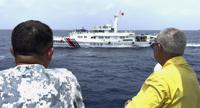BEIRUT (AP) — The leader of Syria's most powerful insurgent group toured the seized city of Aleppo on Wednesday in a surprise visit — the first since the group captured large parts of the city over the weekend as fierce fighting intensifies in the government-led counter-offensive in northern Hama.
, who heads the jihadi group , greeted crowds of supporters near the city's iconic citadel as he smiled and waved in dark green military garb. Surrounded by masked gunmen in flak jackets, men and boys chanted “God is great” as he walked through the heart of Syria's largest city.
The sudden capture of Aleppo, also an ancient business hub, was a stunning prize for Syrian opponents of President .
It was the first opposition attack on the city since 2016, when a brutal Russian air campaign retook the northwestern city for Assad after rebel forces had initially seized it. Intervention by Russia, Iran and Iranian-allied militant Hezbollah and other groups has allowed Assad to remain in power.
The comes after forces opposed to Assad ousted his troops from Aleppo and seized towns and villages in southern parts of the northwestern Idlib province, likely exploiting the fact that Assad's main regional and international backers were preoccupied with their own wars.
The the jihadi HTS as well as an umbrella group of Turkish-backed Syrian militias called the Syrian ���ϳԹ��� Army. For years, both have entrenched themselves in northwest Idlib province and parts of northern Aleppo, as the battered country reeled from years of political and military stalemates.
The war between Assad and his foreign backers and the array of armed opposition forces seeking his overthrow has killed an estimated half-million people over the past 13 years.
Elsewhere, Syrian authorities said their counteroffensive pushed back insurgents attempting to advance to the strategic central city of Hama, while the insurgents said they captured more Syrian troops and Iran-backed militants in fierce battles.
Syrian state SANA news agency on Wednesday said insurgents retreated some 20 kilometers (12 miles) from government-held Hama, Syria's fourth-largest city, as government troops backed by Russian airpower entrenched themselves in the outskirts. as Damascus fears that the insurgents will make their way into Hama as they did over the weekend into Aleppo.
A Syrian photographer working for the German news agency dpa was killed in an airstrike near Hama, the agency said Wednesday. Anas Alkharboutli, 32, has long documented Syria’s civil war, which started after a brutal crackdown on a popular uprising against Assad in 2011. He has worked for dpa since 2017.
Ali Suleiman, a freelance journalist who was with Alkharboutli when the strike happened but was unharmed, said that a low-flying plane circled overhead before striking at a group of journalists — which Suleiman said indicated the targeting was deliberate. Alkharboutli was seriously wounded and succumbed to his wounds a short while later as he was being taken in an ambulance back to Idlib.
The insurgents claimed on their Military Operations Department channel on the Telegram app that they captured five Iran-backed militants, of whom two were from Afghanistan, as well as three Syrian troops from its 25th Special Mission Forces Division in eastern Hama. The claims could not be independently confirmed.
If the insurgents seize the city of Hama and take control of the province, it could leave the coastal cities of Tartous and Lattakia isolated from the rest of the country. Lattakia is a key political stronghold for Assad and Syria's Alawite minority and a strategic Russian naval base.
Tens of thousands have been displaced by the fighting, which started last week, Geir Pedersen, the U.N. special envoy for Syria, said Tuesday.
“If we do not see de-escalation and a rapid move to a serious political process, involving the Syrian parties and the key international players, then I fear we will see a deepening of the crisis," Pedersen said in an address to the U.N. Security Council. "Syria will be in grave danger of further division, deterioration, and destruction."
About 3,000 displaced people from the Hama countryside and Aleppo made their way to the city of Homs, with many more on the way. Those who arrived and found shelter in schools told The Associated Press that they spent hours in traffic, many struggling to afford surging gas prices.
Nidal Assaf, 38, fled the northern Hama countryside where the insurgents seized several towns and villages. Speaking from a school-turned-shelter in Homs, he said the local residents and the army couldn't handle the attackers, and that he had to flee amid the fighting with his family and tens of relatives.
“People eventually had to flee,” he said.
Youssef Choueib said he fled Aleppo to Homs for the third time since 2011. First, he left when rebels last took the city, then after a massive , and finally now.
Many of his family are still in Aleppo, he said. “They called me many times, but they said they couldn’t leave. They tell me there is no bread. There is no food at all.”
Turkey, which backs Syria's opposition, has called on Assad to reconcile with opposition forces and include them in any political solution to end the conflict.
Ankara has been seeking to normalize ties with Syria to address security threats from groups affiliated with Kurdish militants along its southern border and to help ensure the safe return of more than 3 million Syrian refugees. Assad has insisted that Turkey’s withdrawal of its military forces from northern Syria be a condition for any normalization between the two countries.
Damascus views the insurgents as terrorists, and Assad has vowed to respond to the insurgency with an iron fist.
Turkish and Iranian officials met earlier this week, in a bid to reach a solution to de-escalate the flareup. Arab countries bordering Syria, which once backed groups that tried to overthrow Assad, have expressed concern of the conflict's regional impacts, and have backed the president.
___
Associated Press writer Albert Aji in Homs, Syria, contributed to this report.
















































